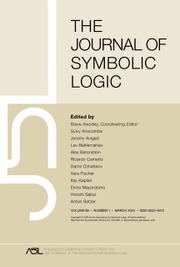No CrossRef data available.
Article contents
THE COMPLEXITY OF ORDER-COMPUTABLE SETS
Published online by Cambridge University Press: 24 January 2025
Abstract
This paper studies the conjecture of Hirschfeldt, Miller, and Podzorov in [13] on the complexity of order-computable sets, where a set A is order-computable if there is a computable copy of the structure  $(\mathbb {N}, <,A)$ in the language of linear orders together with a unary predicate. The class of order-computable sets forms a subclass of
$(\mathbb {N}, <,A)$ in the language of linear orders together with a unary predicate. The class of order-computable sets forms a subclass of  $\Delta ^{0}_{2}$ sets. Firstly, we study the complexity of computably enumerable (c.e.) order-computable sets and prove that the index set of c.e. order-computable sets is
$\Delta ^{0}_{2}$ sets. Firstly, we study the complexity of computably enumerable (c.e.) order-computable sets and prove that the index set of c.e. order-computable sets is  $\Sigma ^{0}_{4}$-complete. Secondly, as a corollary of the main result on c.e. order-computable sets, we obtain that the index set of general order computable sets is
$\Sigma ^{0}_{4}$-complete. Secondly, as a corollary of the main result on c.e. order-computable sets, we obtain that the index set of general order computable sets is  $\Sigma ^{0}_{4}$-complete within the index set of
$\Sigma ^{0}_{4}$-complete within the index set of  $\Delta ^{0}_{2}$ sets. Finally, we continue to study the complexity of more general
$\Delta ^{0}_{2}$ sets. Finally, we continue to study the complexity of more general  $\Delta ^{0}_{2}$ sets and prove that the index set of
$\Delta ^{0}_{2}$ sets and prove that the index set of  $\Delta ^{0}_{2}$ sets is
$\Delta ^{0}_{2}$ sets is  $\Pi ^{0}_{3}$-complete.
$\Pi ^{0}_{3}$-complete.
Information
- Type
- Article
- Information
- Copyright
- © The Author(s), 2025. Published by Cambridge University Press on behalf of The Association for Symbolic Logic


